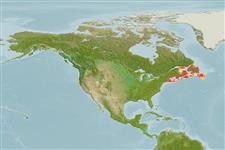Actinopterígios (peces con aletas radiadas) >
Perciformes (Perch-likes) >
Stichaeidae (Pricklebacks) > Stichaeinae
Etymology: Ulvaria: Latin, ulva = sedge (Ref. 45335).
Medioambiente / Clima / Gama
Ecología
; marino bentopelágico. Temperate, preferred ?; 52°N - 41°N
Northwest Atlantic: northern Newfoundland (Strait of Belle Isle) in Canada to southern Massachusetts in USA.
Tamaño / Peso / Age
Maturity: Lm ? range ? - ? cm
Max length : 18.0 cm TL macho / no sexado; (Ref. 7251)
Found among algae on rocky shores and on hard bottom in deeper water, or depth of 55 meters or more (Ref. 51666). Male guards multiple egg masses (Ref. 58332).
Life cycle and mating behavior
Madurez | Reproducción | Puesta | Huevos | Fecundidad | Larva
Eggs are laid in several clumps or masses which are guarded by the male parent (Ref. 58332).
Robins, C.R. and G.C. Ray, 1986. A field guide to Atlantic coast fishes of North America. Houghton Mifflin Company, Boston, U.S.A. 354 p. (Ref. 7251)
IUCN Red List Status (Ref. 115185)
CITES (Ref. 94142)
Not Evaluated
Threat to humans
Harmless
Human uses
Más información
ReferenciasAcuiculturaPerfil de acuiculturaRazasGenéticaFrecuencias de alelosheritabilidadEnfermedadesProcesamientoMass conversion
ColaboradoresImágenesStamps, CoinsSonidosCiguateraVelocidadTipo de nataciónSuperficie branquialOtolitosCerebrosVisión
Herramientas
Special reports
Download XML
Fuentes de Internet
Estimates of some properties based on models
Phylogenetic diversity index (Ref.
82805): PD
50 = 1.0000 [Uniqueness, from 0.5 = low to 2.0 = high].
Bayesian length-weight: a=0.00407 (0.00170 - 0.00978), b=3.10 (2.89 - 3.31), in cm Total Length, based on LWR estimates for this (Sub)family-body shape (Ref.
93245).
Nivel trófico (Ref.
69278): 4.4 ±0.0 se; Based on diet studies.
Resiliencia (Ref.
69278): Medio, población duplicada en un tiempo mínimo de 1.4-4.4 años (K=0.19-0.22; tmax=10).
Vulnerability (Ref.
59153): Moderate vulnerability (40 of 100) .
